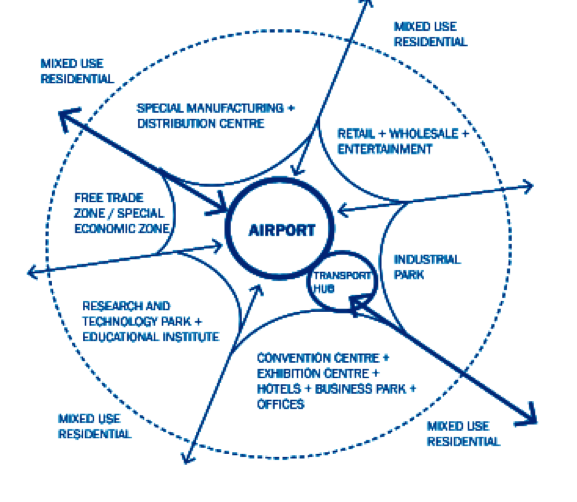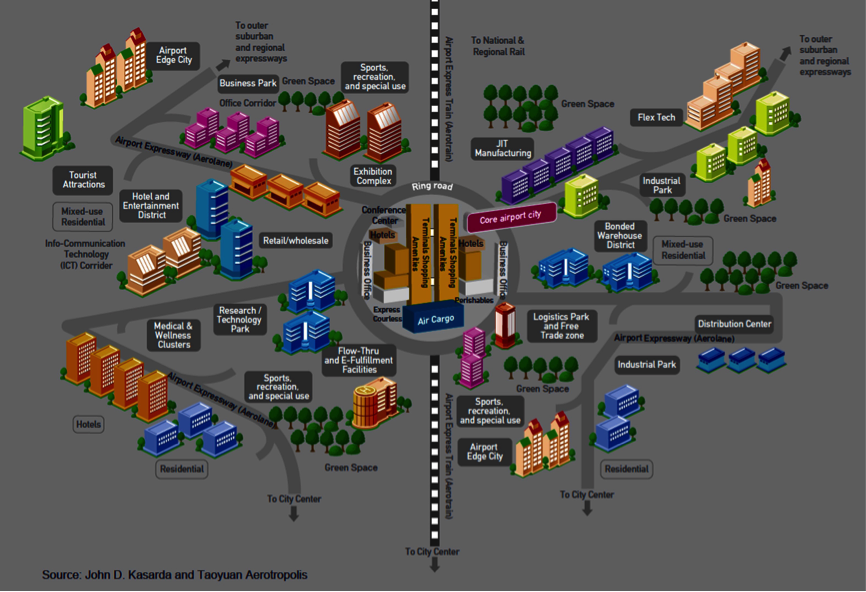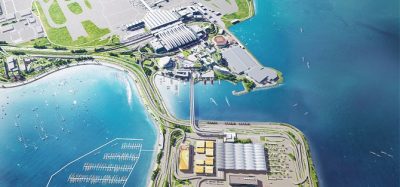Aerotropolis 3: A deeper understanding
- Like
- Digg
- Del
- Tumblr
- VKontakte
- Buffer
- Love This
- Odnoklassniki
- Meneame
- Blogger
- Amazon
- Yahoo Mail
- Gmail
- AOL
- Newsvine
- HackerNews
- Evernote
- MySpace
- Mail.ru
- Viadeo
- Line
- Comments
- Yummly
- SMS
- Viber
- Telegram
- Subscribe
- Skype
- Facebook Messenger
- Kakao
- LiveJournal
- Yammer
- Edgar
- Fintel
- Mix
- Instapaper
- Copy Link
Posted: 29 March 2016 | Dr Sarkar | No comments yet
An aerotropolis is a region that develops and grows within an airport and related activities as central economic growth drivers and the hub of economic activity…
An aerotropolis is a region that develops and grows within an airport and related activities as central economic growth drivers and the hub of economic activity.
The region as a whole may gain a competitive advantage over other business centres by utilising the mutual synergies between various business types, proximity to transportation infrastructure and with each other.
At a micro scale, a typical aerotropolis may include separate zones for office business parks, hotels, logistics parks, industrial parks, e-commerce centres, retail centres, distribution centres, information technology complexes and wholesale merchandise marts that may benefit by locating themselves around an airport and along the transportation corridors surrounding them.
Additional regional amenities such as convention centres, and entertainment complexes can add value to any typical aerotropolis development. The business core may be surrounded by mixed-use residential areas. A multi-modal transportation hub provides transit connectivity for regional population to key areas of the aerotropolis (Figure 1).


Figure 1: A Graphic Presentation of Design Layout of an Aerotropolis. Source: This diagram and the above explanation is based on aerotropolis concepts explained on http://www.aerotropolis.com
As aviation-related businesses cluster around airports with good access to ground transportation, a new business concept is emerging globally: the aerotropolis. Designed to attract economic investment and workforce talent, an aerotropolis is an urban planning area in which the infrastructure and economy centre on an airport.
In 2011, Time Magazine featured the Aerotropolis concept as one of “ideas that will change the world”. The East County Economic Development Council (ECEDC) has begun studying the best ways to create an aerotropolis surrounding county-operated Gillespie Field, a public airport in El Cajon. The ECEDC and the South County Economic Development Council (SCEDC) jointly have received a $40,000 grant from the U.S. Economic Development Administration to develop Aerotropolis plans surrounding both Gillespie Field and San Diego’s Brown Field Municipal Airport in Otay Mesa (Figure 2).
One of the goals is to determine which industry clusters can best enhance economic development, increase investment, and create higher paying jobs. Although it is collaborating with the SCEDC, the East County group’s main focus will be on Gillespie Field, said Santee City Councilman John Minto, chairman of the ECEDC.
In addition to the $40,000 grant, the ECEDC has “received another $50,000 from the San Diego Foundation and we are matching with some internal money as well”, according to Jo Marie Diamond, president and CEO of the council.
If successful, an aerotropolis could become a catalyst for economic growth that benefits the entire East County community, she explained: “The underlying premise of an aerotropolis is an economic accelerator.”


Figure 2: An aerial view of an aerotropolis with full landscape designs
The Wall Street Journal reports that in countries like Dubai, China, India and Africa, cities are being built from scratch around air travel. The ECEDC’s goal is to create a business hub where travellers and locals can conduct business, shop, and dine. This would benefit manufacturing and distribution facilities; hotels; retail stores; commercial offices; conference centres; and entertainment venues.
In addition to incorporating a variety of commercial and entertainment venues into passenger terminals, airports are developing their landside areas with hospitality clusters, office and retail complexes, conference and exhibition centres, logistics and free trade zones and facilities for processing time-sensitive goods. Revenues from such developments are being reinforced by major financial streams from advertising and parking. Consequently, many airports now receive greater percentages of their revenues from non-aeronautical sources rather than more traditional aeronautical sources (landing fees, gate leases, passenger service charges).
For some, such as Atlanta, Dallas, Hong Kong and Schiphol, non-aeronautical activities contribute approximately two-thirds of total airport revenues. These non-aeronautical revenues have become critical to airports meeting their facility modernisation and aeronautical infrastructure expansion needs, along with their being cost-competitive in attracting and retaining airlines.
With the airport itself serving as a region-wide multi-modal transportation and commercial nexus, strings and clusters of airport-linked business parks, information and communications technology complexes, retail, hotel and entertainment centres, industrial parks, logistics parks, wholesale merchandise marts and residential developments are forming along airport arteries up to 20 miles outward. Economic impact has been measured up to 60 miles from some major airports.
About the author
After obtaining his Master in Science from the Madras University, and Doctorate Degree in Geochemistry and Earth Sciences from the University of Wales, Dr. A N Sarkar worked for more than four decades in the Petrochemicals-related fields, R& D, Environment, Central Ministries, External Donor Agencies, and Academics. He served as a Chair Professor-National Agricultural Bank for Rural Development (NABARD); Professor, University of Petroleum and Energy Studies.
More recently, Dr. Sarkar has worked as a Senior Professor (International Business) and Dean (Research) in the Asia-Pacific Institute of Management, New Delhi. He has also served as convener and member secretaries in various Inter-Ministerial Committees on ‘Natural Resources Management’, ‘Sustainable Development’ and ‘Renewable Energy’. Dr. Sarkar has so far authored 22 Books and more than 100 research papers, published in reputed national and international journals.
His books include: Energy Security, Global Climate Change & Sustainable Energy Development, Emission Trading & Carbon Management and Petro-Economics (Pentagon Press, New Delhi); Global Climate Economics (LAP, Publishing Corporation, Germany); CSR in Mining Industry (LAP, Publishing Corporation, Germany), Green Banking, Microfinance, Eco-Industrial Clusters (Atlantic Publishing House), Environmental Economics, Energy, Environment and Global Climate Economics (Discovery Publishing).
Click here to contact Dr Sarkar.

















